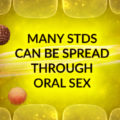The term STD or VD stands for Venereal Disease, a group of diseases transmitted through sexual activity (Oral sex, vaginal sex, and anal sex). The term venereal is derived from the Latin word venereus which relates to sexual intercourse or desire, linked with the Roman goddess Venus. Venereal Diseases are also known as sexually transmitted diseases or STDs.
KEY FACTS ON STD
According to the World Health Organization,
Key facts
- More than 1 million sexually transmitted infections (STIs) are acquired every day worldwide (1, 2).
- Each year, there are an estimated 376 million new infections with 1 of 4 STIs: chlamydia, gonorrhea, syphilis, and trichomoniasis (1, 2).
- More than 500 million people are estimated to have genital infections with herpes simplex virus (HSV) (3).
- More than 290 million women have a human papillomavirus (HPV) infection (4).
- The majority of STIs have no symptoms or only mild symptoms that may not be recognized as an STI.
- STIs such as HSV type 2 and syphilis can increase the risk of HIV acquisition.
- 988 000 pregnant women were infected with syphilis in 2016, resulting in over 350 000 adverse birth outcomes including 200 000 stillbirths and newborn deaths (5).
- In some cases, STIs can have serious reproductive health consequences beyond the immediate impact of the infection itself (e.g., infertility or mother-to-child transmission)
- The Gonococcal Antimicrobial Resistance Surveillance Programme has shown high rates of quinolone resistance, increasing azithromycin resistance, and emerging resistance to extended-spectrum cephalosporins. Drug resistance, especially for gonorrhea, is a major threat to reducing the impact of STIs worldwide.
Asymptomatic STIs
Many STIs have no signs or symptoms (asymptomatic). Even with no symptoms, however, you can pass the infection to your sex partners. So it’s important to use protection, such as a condom, during sex. And visit your doctor regularly for STI screening, so you can identify and treat an infection before you can pass it on.
Some of the following diseases, such as hepatitis, can also be transmitted without sexual contact, by coming into contact with an infected person’s blood. Others, such as gonorrhea, can only be transmitted through sexual contact.
Chlamydia symptoms
Chlamydia is a bacterial infection of your genital tract. Chlamydia may be difficult to detect because early-stage infections often cause few or no signs and symptoms. When they do occur, they usually start one to three weeks after you’ve been exposed to chlamydia. Even when signs and symptoms occur, they’re often mild and passing, making them easy to overlook.
Signs and symptoms may include:
- Painful urination
- Lower abdominal pain
- Vaginal discharge in women
- Discharge from the penis in men
- Pain during sexual intercourse in women
- Bleeding between periods in women
- Testicular pain in men
Gonorrhea symptoms
Gonorrhea is a bacterial infection of your genital tract. It can also grow in your mouth, throat, eyes, and anus. The first gonorrhea symptoms generally appear within 10 days after exposure. However, some people may be infected for months before signs or symptoms occur.
Signs and symptoms of gonorrhea may include:
- Thick, cloudy or bloody discharge from the penis or vagina
- Pain or burning sensation when urinating
- Heavy menstrual bleeding or bleeding between periods
- Painful, swollen testicles
- Painful bowel movements
- Anal itching
Trichomoniasis symptoms
Trichomoniasis is a common STI caused by a microscopic, one-celled parasite called Trichomonas vaginalis. This organism spreads during sexual intercourse with someone who already has the infection.
The organism usually infects the urinary tract in men, but often causes no symptoms. Trichomoniasis typically infects the vagina in women. When trichomoniasis causes symptoms, it may appear within five to 28 days of exposure and range from mild irritation to severe inflammation.
Signs and symptoms may include:
- Clear, white, greenish, or yellowish vaginal discharge
- Discharge from the penis
- Strong vaginal odor
- Vaginal itching or irritation
- Itching or irritation inside the penis
- Pain during sexual intercourse
- Painful urination
HIV symptoms
HIV is an infection with the human immunodeficiency virus. HIV interferes with your body’s ability to fight off viruses, bacteria, and fungi that cause illness, and it can lead to AIDS, a chronic, life-threatening disease.
When first infected with HIV, you may have no symptoms. Some people develop a flu-like illness, usually two to six weeks after being infected. Still, the only way you know if you have HIV is to be tested.
Early signs and symptoms
Early HIV signs and symptoms may include:
- Fever
- Headache
- Sore throat
- Swollen lymph glands
- Rash
- Fatigue
These early signs and symptoms usually disappear within a week to a month and are often mistaken for those of another viral infection. During this period, you’re highly infectious. More persistent or -severe symptoms of HIV infection may not appear for 10 years or more after the initial infection.
As the virus continues to multiply and destroy immune cells, you may develop mild infections or chronic signs and symptoms such as:
- Swollen lymph nodes — often one of the first signs of HIV infection
- Diarrhea
- Weight loss
- Fever
- Cough and shortness of breath
Late-stage HIV infection
Signs and symptoms of late-stage HIV infection include:
- Persistent, unexplained fatigue
- Soaking night sweats
- Shaking chills or fever higher than 100.4 F (38 C) for several weeks
- Swelling of lymph nodes for more than three months
- Chronic diarrhea
- Persistent headaches
- Unusual, opportunistic infections
Genital herpes symptoms
Highly contagious, genital herpes is caused by a type of herpes simplex virus (HSV) that enters your body through small breaks in your skin or mucous membranes. Most people with HSV never know they have it because they have no signs or symptoms or the signs and symptoms are so mild they go unnoticed.
When signs and symptoms are noticeable, the first episode is generally the worst. Some people never have a second episode. Others, however, can have recurrent episodes for decades.
When present, genital herpes signs and symptoms may include:
- Small red bumps, blisters (vesicles), or open sores (ulcers) in the genital, anal and nearby areas
- Pain or itching around the genital area, buttocks, and inner thighs
The initial symptom of genital herpes usually is pain or itching, beginning within a few weeks after exposure to an infected sexual partner. After several days, small red bumps may appear. They then rupture, becoming ulcers that ooze or bleed. Eventually, scabs form and the ulcers heal.
In women, sores can erupt in the vaginal area, external genitals, buttocks, anus, or cervix. In men, sores can appear on the penis, scrotum, buttocks, anus or thighs, or inside the tube from the bladder through the penis (urethra).
Ulcers can make urination painful. You may also have pain and tenderness in your genital area until the infection clears. During an initial episode, you may have flu-like signs and symptoms, such as a headache, muscle aches, and fever, as well as swollen lymph nodes in your groin.
In some cases, the infection can be active and contagious even when sores aren’t present.
Human papillomavirus (HPV) infection and genital warts symptoms
HPV infection is one of the most common types of STI. Some forms put women at high risk of cervical cancer. Other forms cause genital warts. HPV usually has no signs or symptoms. The signs and symptoms of genital warts include:
- Small, flesh-colored, or gray swellings in your genital area
- Several warts close together that take on a cauliflower shape
- Itching or discomfort in your genital area
- Bleeding with intercourse
Often, however, genital warts cause no symptoms. Genital warts may be as small as 1 millimeter in diameter or may multiply into large clusters.
In women, genital warts can grow on the vulva, the walls of the vagina, the area between the external genitals and the anus, and the cervix. In men, they may occur on the tip or shaft of the penis, the scrotum, or the anus. Genital warts can also develop in the mouth or throat of a person who has had oral sex with an infected person.
Hepatitis symptoms
Hepatitis A, hepatitis B, and hepatitis C are all contagious viral infections that affect your liver. Hepatitis B and C are the most serious of the three, but each can cause your liver to become inflamed.
Some people never develop signs or symptoms. But for those who do, signs and symptoms may occur several weeks after exposure and may include:
- Fatigue
- Nausea and vomiting
- Abdominal pain or discomfort, especially in the area of your liver on your right side beneath your lower ribs
- Loss of appetite
- Fever
- Dark urine
- Muscle or joint pain
- Itching
- Yellowing of your skin and the whites of your eyes (jaundice)
Syphilis symptoms
Syphilis is a bacterial infection. The disease affects your genitals, skin, and mucous membranes, but it can also involve many other parts of your body, including your brain and your heart.
The signs and symptoms of syphilis may occur in four stages — primary, secondary, latent, and tertiary. There’s also a condition known as congenital syphilis, which occurs when a pregnant woman with syphilis passes the disease to her unborn infant. Congenital syphilis can be disabling, even life-threatening, so it’s important for a pregnant woman with syphilis to be treated.
Primary syphilis
The first sign of syphilis, which may occur from 10 days to three months after exposure, may be a small, painless sore (chancre) on the part of your body where the infection was transmitted, usually your genitals, rectum, tongue, or lips. A single chancre is typical, but there may be multiple sores.
The sore typically heal without treatment, but the underlying disease remains and may reappear in the second (secondary) or third (tertiary) stage.
Secondary syphilis
Signs and symptoms of secondary syphilis may begin three to six weeks after the chancre appears, and may include:
- Rash marked by red or reddish-brown, penny-sized sores over any area of your body, including your palms and soles
- Fever
- Enlarged lymph nodes
- Fatigue and a vague feeling of discomfort
- Soreness and aching
These signs and symptoms may disappear without treatment within a few weeks or repeatedly come and go for as long as a year.
Latent syphilis
In some people, a period called latent syphilis — in which no symptoms are present — may follow the secondary stage. Signs and symptoms may never return, or the disease may progress to the tertiary stage.
Tertiary syphilis
Without treatment, syphilis bacteria may spread, leading to serious internal organ damage and death years after the original infection.
Some of the signs and symptoms of tertiary syphilis include:
- Lack of coordination
- Numbness
- Paralysis
- Blindness
- Dementia
Neurosyphilis
At any stage, syphilis can affect the nervous system. Neurosyphilis may cause no signs or symptoms, or it can cause:
- Headache
- Behavior changes
- Movement problems
If you suspect you have an STI, see your doctor
If you suspect you have these or other STIs or that you may have been exposed to one, see your doctor for testing. Timely diagnosis and treatment are important to avoid or delay more severe, potentially life-threatening health problems and to avoid infecting others.





